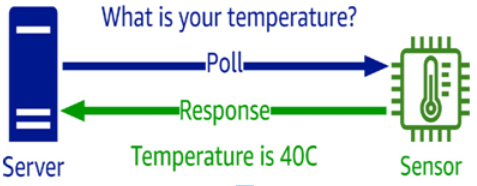Legacy IIoT networking technologies – Getting Started with Edge Computing on AWS
Legacy industrial automation systems relied on a variety of networks and protocols to facilitate communication and control among devices, machines, and systems. Examples include MODBUS, PROFINET, EtherCAT, and Fieldbus. These networks were typically closed systems – islands unto themselves. They were also developed at a time when such devices were limited in number and directly connected via serial cable:

Figure 1.7 – Legacy poll/response IIoT protocols
This is why they typically use a poll/response protocol architecture. Unlike the publish/subscribe and report-by-exception techniques MQTT uses, these protocols require a server to periodically query each device. Those devices, in turn, respond with the requested data.
Poll/response protocols have a number of disadvantages compared to MQTT:
Efficiency: Legacy poll/response protocols require the client to continually ask (poll) the server for data. This can lead to excessive network traffic and wastage of bandwidth, especially when dealing with a large number of devices. MQTT, on the other hand, only publishes updates by exception. For example, an MQTT-based temperature sensor will only publish a new reading if the temperature changes – in a poll/response model, there could be hundreds of duplicate readings sent over the network.
Scalability: Legacy protocols struggle to scale such that they can handle the high number of devices and data points typically found in today’s IIoT environments3. MQTT was designed with scalability in mind and can easily handle communication between a large number of devices.
3 How MQTT is Helping Support the Digital Transformation
Real-time updates: Legacy poll/response protocols may not provide real-time updates as they work on the request/response model. With MQTT, updates can be pushed immediately when the data changes, enabling near real-time communication.
Network resilience: Poll/response protocols offer no guarantee that the data was received. MQTT is designed to work over unreliable networks, and with features such as Quality-of-Service (QoS) levels and “last will and testament,” it ensures data delivery even in challenging network conditions.
Security: Many legacy protocols were not designed with security in mind and do not include built-in security features such as encryption or outbound-only connection initiation, making them vulnerable to cyber-attacks. MQTT uses TCP/IP and supports modern security mechanisms such as SSL/TLS for secure data transmission. MQTT also does not require inbound TCP/UDP ports on clients to be open, as connections are always initiated from the client to the broker.
State awareness: With poll/response, the server does not know the state of the client, while the MQTT broker keeps track of client sessions and their subscriptions, improving the overall awareness of the system’s state.
Flexibility: Legacy protocols may not support diverse data types and structures, limiting flexibility. MQTT, on the other hand, is data-agnostic and can support various data types and complex nested structures, making it more versatile for modern IIoT applications.
Despite these advantages, the older devices do continue to function and often represent a significant capital investment. It is unusual for IIoT deployments to call for a total replacement of those past capital expenses.
You may also like
Archives
- August 2024
- July 2024
- June 2024
- May 2024
- April 2024
- March 2024
- February 2024
- January 2024
- December 2023
- November 2023
- October 2023
- September 2023
- August 2023
- July 2023
- May 2023
- April 2023
- February 2023
- January 2023
- November 2022
- October 2022
- September 2022
- August 2022
- July 2022
- June 2022
- May 2022
- April 2022
- December 2021
- November 2021
- October 2021
- September 2021
- June 2021
Calendar
| M | T | W | T | F | S | S |
|---|---|---|---|---|---|---|
| 1 | 2 | 3 | 4 | 5 | 6 | |
| 7 | 8 | 9 | 10 | 11 | 12 | 13 |
| 14 | 15 | 16 | 17 | 18 | 19 | 20 |
| 21 | 22 | 23 | 24 | 25 | 26 | 27 |
| 28 | 29 | 30 | ||||
Leave a Reply